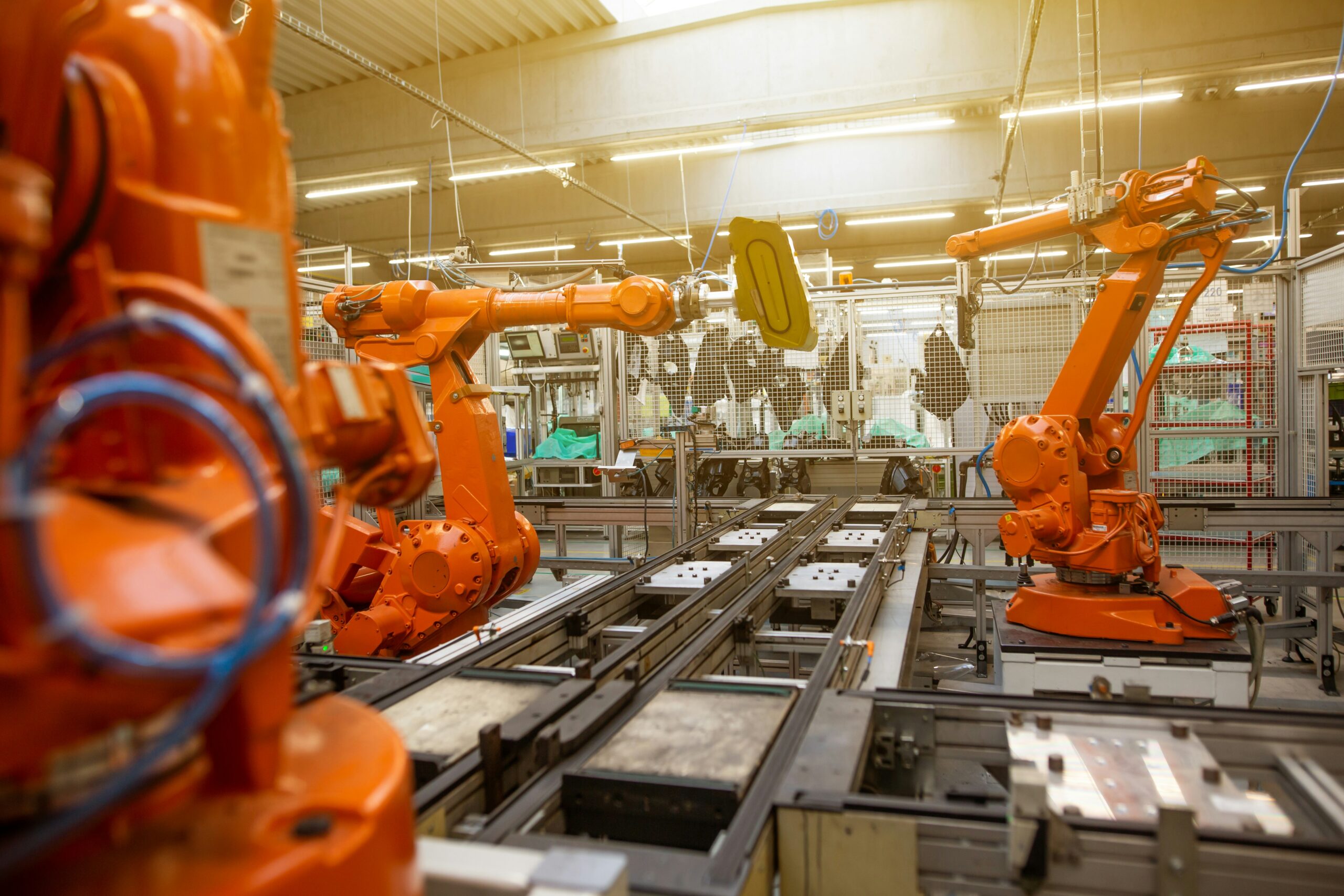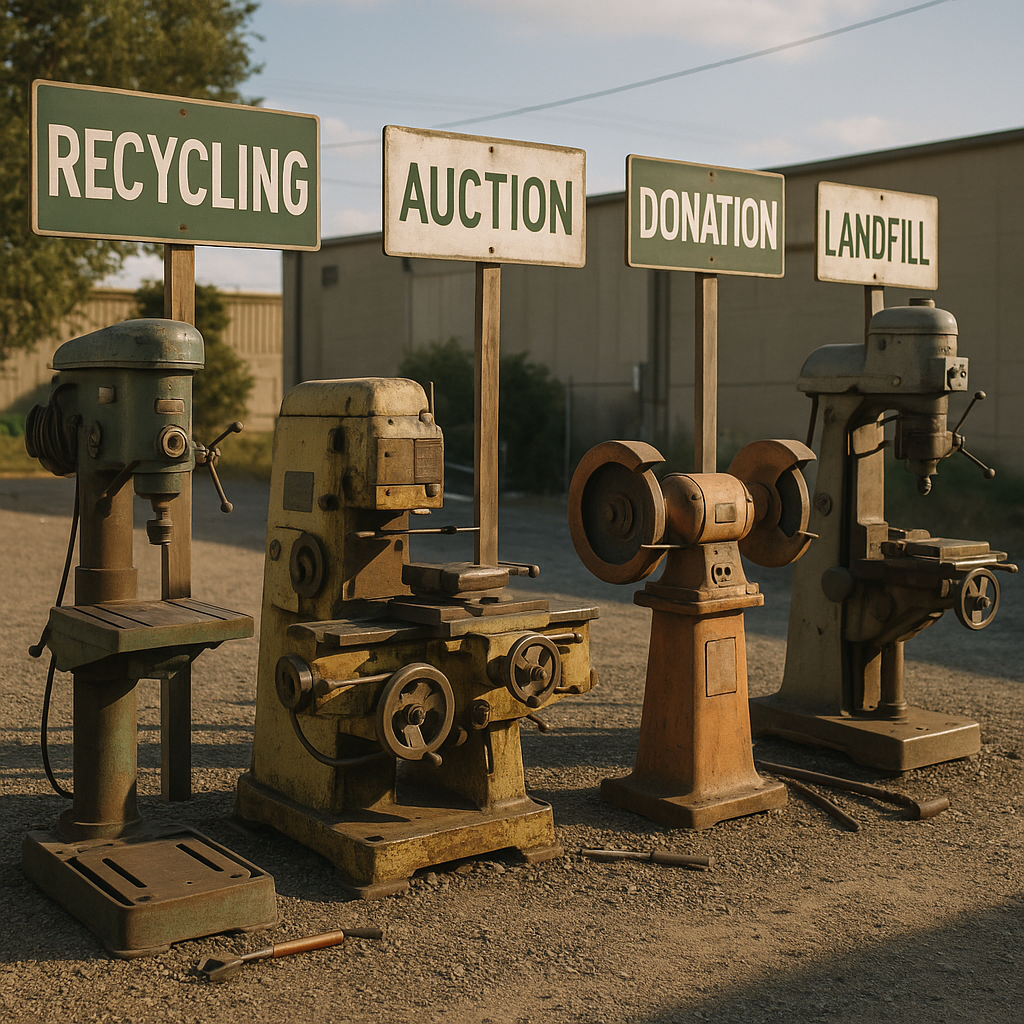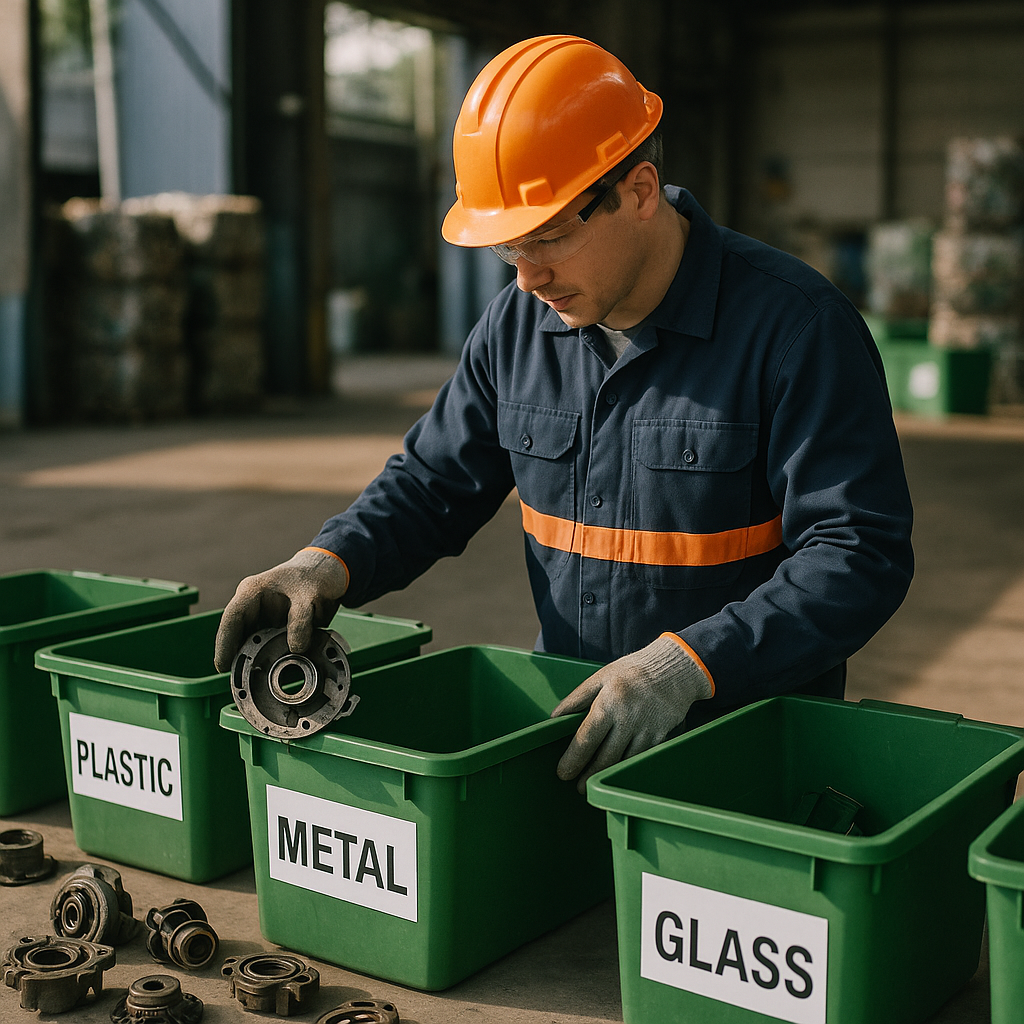5901 Botham Jean Blvd, Dallas, TX 75215
Industrial Equipment Disposal: How to Responsibly Recycle or Sell Used Machinery
July 13, 2025The manufacturing floor that once hummed with productivity now houses a growing collection of outdated equipment. In the corner sits a press machine that hasn’t operated efficiently in years. Against the wall, obsolete conveyor systems gather dust. This scenario occurs in industrial facilities across the country every day.
When machinery reaches the end of its useful life, it creates significant challenges for business owners. These metal giants consume valuable floor space that could otherwise support revenue-generating activities. They represent tied-up capital and ongoing maintenance costs with diminishing returns.
The disposal question looms large for many operations managers. Simply discarding industrial equipment isn’t an option in today’s regulatory environment. Equipment often contains materials requiring special handling. Navigating the proper channels for machinery disposal can feel overwhelming, especially when considering both environmental responsibility and financial implications.
How Do You Determine When It’s Time to Dispose of Machinery?

Recognizing when to dispose of industrial machinery is a crucial business decision affecting both operational efficiency and profitability. This decision should derive from objective assessments rather than emotional ties to equipment that has served well over the years.
Every piece of equipment has a lifespan. Even the most robust industrial machinery eventually reaches a stage where its continued use becomes impractical. The key is identifying these signs before the equipment leads to costly issues or safety risks.
Evaluate Machine Performance and Efficiency
A decline in performance is often the first sign that machinery has outlived its useful life. When equipment slows down or delivers inconsistent results, it impacts productivity across operations.
Efficiency losses are particularly significant. Modern machinery generally operates with greater energy efficiency than older models. If your equipment requires more energy, fuel, or resources to perform tasks it previously handled with less, the increased operational costs may warrant replacement.
Analyze Repair Frequency and Costs
Repair costs typically follow a predictable pattern throughout the lifespan of equipment. New machinery rarely needs repairs, but as it ages, maintenance requirements increase significantly. This escalation indicates the nearing end of most machinery’s lifecycle.
The relationship between repair costs and machine value aids in disposal decisions. When accumulated repair costs reach or surpass 30-40% of the machine’s current market value, further investment becomes questionable. Similarly, if a single repair costs more than half the machine’s value, replacement is usually more cost-effective.
Consider Maintenance Requirements
Increasing maintenance intervals strain resources beyond just repair costs. Each maintenance event demands staff time, disrupts operations, and potentially delays production schedules.
Parts availability becomes another crucial factor. When manufacturers discontinue support for older equipment models, securing replacement parts becomes harder and more expensive, leading to premium prices or custom fabrication needs.
Assess Operational Impact
The true cost of aging equipment transcends direct maintenance expenses. Equipment requiring frequent downtime causes ripple effects throughout operations:
- Production delays and missed deadlines
- Increased labor costs due to workflow disruptions
- Quality control issues from inconsistent performance
- Safety risks from unpredictable operation
- Higher energy consumption and utility bills
These hidden costs often outweigh the visible expenses associated with repairs and maintenance. A thorough assessment should consider these operational impacts.
Weigh Replacement Benefits
Technological advancements continuously enhance machinery capabilities. Newer equipment generally offers improved features, greater efficiency, enhanced safety measures, and reduced environmental impact. These benefits can strongly justify replacement even if older equipment still functions.
Compliance requirements also evolve over time. Updated regulations for emissions, energy consumption, noise levels, or safety features may render older machinery non-compliant. Retrofitting older equipment to meet new standards usually costs more than replacement.
Equipment Disposal Evaluation Checklist
Use this checklist to objectively assess whether your machinery has reached its disposal point:
- Is the equipment breaking down more than once per month?
- Have repair costs exceeded 30% of the machine’s current value in the past year?
- Are replacement parts hard to source or priced at premium levels?
- Has productivity declined by over 15% compared to optimal performance?
- Does the equipment consume significantly more energy or resources than newer models?
- Would a newer model provide substantial operational improvements or cost savings?
- Does the equipment pose safety concerns that modern alternatives would address?
- Would maintenance costs and operational losses exceed the depreciation costs of new equipment?
If you answered “yes” to three or more of these questions, it might be time to consider equipment replacement. Each “yes” represents a financial drain that accumulates over time.
Cost-Benefit Analysis
A comprehensive cost-benefit analysis provides a clear route to disposal decisions. Calculate the total cost of ownership for both retaining existing equipment and acquiring replacements. Consider all factors:
For existing equipment, factor in expected repair costs, maintenance requirements, operational inefficiencies, and residual value. For replacement options, consider purchase price, installation costs, training needs, and improved operational efficiencies.
This analysis often reveals that seemingly high replacement costs are offset by cumulative savings and productivity gains from new equipment.
[[artifact_table]] Equipment Disposal Decision Matrix: Comparison of Annual Costs Between Keeping vs. Replacing Equipment [[/artifact_table]]When equipment is beyond economical repair but still contains valuable materials, recycling becomes an environmentally responsible disposal option. Many industrial machines contain metals and components that can be recovered and repurposed, turning disposal costs into potential value.
What Are the Main Options for Disposing of Old Machinery?

When industrial machinery reaches the end of its useful life, businesses face important decisions about disposal. The right choice not only impacts your bottom line but also has significant environmental implications. From selling to scrapping, each method offers unique benefits depending on your equipment’s condition and value.
Selling Your Machinery Directly to Buyers
Direct selling offers the highest potential return but requires more effort. This approach is ideal for well-maintained equipment. You will need to manage marketing, negotiate with buyers, and handle all transaction logistics.
When selling directly, prepare detailed maintenance records and equipment specifications to show value. Many businesses utilize online marketplaces or industry networks to find buyers. Although this method generally takes longer than other disposal options, the financial returns often justify the wait.
According to industry data, companies investing time in finding the right buyer can recover up to 40-60% of the original equipment value, especially for specialized or in-demand machinery.
Working with Equipment Brokers
Partnering with a broker offers convenience for quick machinery disposal. Brokers manage the entire sales process, from valuation to finding buyers and closing deals. They provide valuable market insights and access to networks of potential purchasers.
Most brokers work on a commission basis, usually 5-12% of the final sale price. While this reduces your net return, the time saved and broader market reach can make this option worthwhile for many businesses looking to dispose of industrial equipment efficiently.
Auctioning Equipment
Auctions excel at creating competitive bidding for high-demand machinery. This method requires minimal effort and can attract a global audience. Modern auctions offer both online and on-site bidding options, greatly expanding your potential market.
Equipment values at auction have increased in recent years, with some heavy machinery categories seeing 15-20% increases. For instance, an average piece of construction equipment might fetch around $67,000 at auction, making it a viable option for valuable machinery.
Auctions come in two main formats: reserve auctions (with minimum price requirements) and non-reserve auctions (sold to the highest bidder regardless of price). The latter typically attracts more potential buyers but offers less price control.
Trading In Your Old Equipment
Trading in old machinery when purchasing new equipment offers significant convenience. Dealers handle logistics and paperwork, making this one of the simplest disposal methods. While you might not maximize financial returns, reduced hassle and potential tax benefits can make trade-ins attractive.
Dealers evaluate trade-ins based on appearance, mechanical condition, age, operating hours, maintenance records, and current market demand. This option works best when you’re planning to purchase new equipment from the same vendor.
Recycling and Scrapping
For machines beyond repair or with minimal resale value, recycling or scrapping is often the most practical option. Modern facilities dismantle equipment to recover valuable metals and materials, keeping them out of landfills and giving them new life in manufacturing.
Materials like copper, steel, brass, iron, and aluminum are particularly valuable in the recycling process. Non-ferrous metals (those not containing iron) typically command higher prices at scrap yards. While financial returns are lower than selling functional equipment, recycling provides environmental benefits and some cost recovery.
Recycling industrial equipment significantly reduces energy consumption compared to manufacturing with raw materials. For example, recycling aluminum saves about 95% of the energy required to produce new aluminum from raw materials.
Donating Used Equipment
Equipment donation offers dual benefits: supporting worthy causes while potentially securing tax advantages. Educational institutions, non-profit organizations, and charitable foundations often welcome machinery donations for training programs or operational use.
For tax purposes, donations of equipment valued over $5,000 typically require an independent appraisal. While this adds some cost, the overall tax benefit can still provide meaningful financial advantages, especially for higher-value donations.
Some organizations specialize in specific equipment types. For example, the Historical Construction Equipment Association preserves historically significant machinery for educational purposes, offering a unique destination for truly vintage equipment.
| Disposal Method | Description | Potential Return | Environmental Impact |
|---|---|---|---|
| Selling Directly | Sell to buyers, requiring more effort but potentially higher return. | Up to 40-60% of original value | Minimal environmental impact if reused. |
| Using Equipment Brokers | Brokers handle sales for a commission. | Commission of 5-12% of sale price | Low impact if equipment reused. |
| Auction | Auctioning reaches a global audience, especially for high-demand items. | Averages around $67,000 for equipment | Low impact, provided it remains in use. |
| Trade-In | Trade old equipment for new purchases, saving effort in disposal. | Convenience and possible tax benefits | Low impact, involved in continued use cycle. |
| Recycling/Scrapping | Recovery of valuable materials through dismantling for recycling. | Lower than selling but recovers costs | Environmentally beneficial by reusing materials. |
| Donation | Donate for potential tax benefits and supporting causes. | Tax advantages | Positive impact by extending equipment life. |
The optimal disposal method depends on the equipment’s condition, age, market demand, and your disposal timeline. By carefully evaluating these factors, you can choose the approach that maximizes financial returns and environmental responsibility.
How Can You Maximize Value When Disposing of Old Equipment?
Strategic planning is key when it’s time to part with old industrial equipment to ensure the best return. Your choice of disposal method significantly affects your profits, timeline, and overall experience. Let’s explore ways to maximize the value from your outdated machinery.
Assess Your Equipment’s Condition
Before listing your equipment for sale, thoroughly evaluate its condition. Buyers seek detailed information about what they’re purchasing. Be transparent about any issues, wear and tear, or necessary repairs.
Documentation boosts buyer confidence. Gather maintenance records, operating manuals, and any applicable warranty information. A well-documented equipment history shows proper care and can justify higher asking prices.
Choose the Right Sales Channel
There are several ways to sell used equipment, each with its own advantages depending on your priorities:
Direct-to-Buyer Sales
Selling directly to end users often yields the highest return but requires more time and effort. This method eliminates middleman fees, allowing you to capture the full value. Online marketplaces and industry forums can connect you with potential buyers.
For success in direct sales, create detailed listings with multiple high-quality photos showing the equipment from various angles. Include specific information about make, model, year, operating hours, and any recent upgrades or repairs.
Broker Partnerships
Partnering with machinery brokers offers a faster sales process with less administrative burden. Brokers leverage their industry connections and expertise to quickly find qualified buyers. While you’ll pay a commission, their market knowledge often results in better pricing than you might achieve on your own.
Select brokers with experience in your specific equipment category. Their targeted approach can connect you with buyers willing to pay premium prices for specialized machinery.
Auction Opportunities
Industrial auctions provide a quick disposal method, especially for equipment that’s functional but not in pristine condition. Popular models often perform well at auctions, as buyers are looking for value opportunities.
Online auctions expand the potential buyer pool globally, increasing competition for desirable equipment. This wider audience can drive prices higher than local-only auctions.
| Disposal Method | Description | Financial Return | Market Demand | Environmental Responsibility |
|---|---|---|---|---|
| Direct Sale to Buyers | Selling equipment directly to end users | High (up to 40-60% of original value) | High, especially for specialized machinery | Depends on buyer’s use and maintenance |
| Equipment Brokers | Using a broker to find buyers and manage sales | Moderate (minus 5-12% commission) | Moderate | Depends on buyer’s intentions |
| Auction | Selling equipment through competitive bidding | Varies (often good for high-demand items) | High | Neutral |
| Trade-In | Trading old machinery for new equipment | Moderate (convenience oriented) | N/A | Neutral |
| Recycling/Scrapping | Dismantling equipment for materials recovery | Low | N/A | High |
| Donation | Donating equipment to educational or non-profit organizations | Low (potential tax benefits) | N/A | High |
Preparation Tips to Boost Resale Value
The effort you invest before listing equipment can significantly impact your final return. Consider these practical steps:
Clean thoroughly inside and out. A well-maintained appearance suggests better mechanical care. Remove any debris, grease, or grime that might make the equipment look neglected.
Make strategic repairs. Fix obvious issues that would deter buyers or significantly lower offers. Focus on repairs with a strong return on investment rather than addressing every minor flaw.
Collect and organize documentation. Compile service records, manuals, and warranty information in a single package. This transparency builds trust with potential buyers.
Timing Your Sale for Maximum Return
Market conditions fluctuate based on economic factors and seasonal demand. In many industries, equipment demand rises at the start of construction or production seasons when companies look to expand or update their fleets.
Research current market trends before listing. If your equipment type is in high demand due to supply chain issues or industry growth, you may command premium pricing. Conversely, during market downturns, holding equipment until conditions improve might be worthwhile.
Highlighting Value-Adding Features
When marketing your equipment, emphasize aspects that distinguish it from similar offerings. Recent upgrades, low operating hours, or rare configurations can justify higher asking prices.
For machinery with specialized capabilities, target buyers in niche industries who understand the unique value. These specialized buyers often pay more than general equipment purchasers because they recognize the specific benefits for their operations.
If your equipment underwent any rebuilds or major component replacements, highlight these improvements. Equipment with new critical components often sells at higher prices than comparable machines with all original parts.
Negotiation Strategies
Set a firm minimum acceptable price before entertaining offers. This preparation prevents hasty decisions that might leave money on the table. While being open to reasonable negotiations shows good faith, having clear boundaries protects your interests.
Consider offering value-added services like delivery, short-term warranties, or basic training to justify your asking price. These additions can make your offer more attractive without reducing the core equipment value.
Remember that the first offer rarely represents a buyer’s best price. Patience during negotiations often yields better results than rushing to close a quick sale.
What Environmental Considerations Are Important When Disposing of Machinery?

Disposing of machinery poses significant environmental challenges requiring careful attention. When industrial equipment reaches the end of its useful life, proper disposal is essential to prevent harm to our ecosystem. Statistics reveal that electronic waste is growing at an alarming rate, with over 50 million metric tons generated globally each year, making it the fastest-growing waste stream in the world.
E-waste from machinery often contains hazardous materials that can leach into soil and water if improperly discarded. Older equipment may contain mercury, lead, cadmium, and brominated flame retardants, posing serious environmental and health risks. These toxins can contaminate groundwater and soil, affecting both wildlife and human communities.
Recycling industrial machinery provides a sustainable alternative to landfill disposal. When properly recycled, up to 90% of materials from old machinery can be recovered and reused in manufacturing new products. This circular approach not only conserves valuable resources but also reduces the energy consumption and carbon emissions associated with extracting and processing new materials.
Environmental Regulations for Machinery Disposal
Federal and state regulations govern the disposal of industrial equipment, especially those containing hazardous components. The Resource Conservation and Recovery Act (RCRA) classifies certain types of e-waste as hazardous, requiring stringent guidelines for handling and disposal. Businesses must follow these regulations or face potential fines and legal consequences.
Many states have enacted specific e-waste laws with additional requirements. Some states prohibit certain electronic components from being disposed of in landfills. Staying informed about these regulations is crucial for legal compliance and environmental protection.
The Environmental Protection Agency (EPA) provides guidance on proper disposal methods and promotes responsible e-waste recycling practices. Following these guidelines ensures that potentially harmful substances are managed safely and do not cause environmental damage.
Choosing Eco-Friendly Disposal Methods
When disposing of machinery, several environmentally responsible options include:
- Certified recycling facilities: Partner with recyclers certified under standards like Responsible Recycling (R2) or e-Stewards to ensure proper handling of materials.
- Asset recovery: Recover valuable components like precious metals and specialized parts before recycling the remainder.
- Refurbishment: Extend the life of equipment through repair and refurbishment when possible.
- Manufacturer take-back programs: Some equipment manufacturers offer programs to take back and properly recycle their products.
The choice of disposal method should consider both environmental impact and data security concerns. For equipment that stored sensitive information, secure data destruction is essential before recycling.
Benefits of Responsible Machinery Disposal
Implementing environmentally responsible disposal practices yields multiple benefits. Beyond regulatory compliance, proper disposal contributes to sustainability goals, reduces carbon footprints, and conserves natural resources. Companies prioritizing eco-friendly disposal often enhance their reputation among environmentally conscious consumers and partners.
Industrial recycling programs help recover valuable materials like steel, aluminum, copper, and precious metals from discarded machinery. These recovered materials require significantly less energy to process compared to mining raw materials. For example, recycling aluminum uses 95% less energy than producing it from bauxite ore.
Additionally, responsible disposal creates jobs in the recycling sector. The e-waste recycling industry employs thousands of workers in collection, processing, and materials recovery, contributing to local economies while solving environmental challenges.
The environmental impacts of improper machinery disposal extend far beyond the immediate area. Electronic waste exported to developing countries often ends up in unregulated dumps where toxic materials contaminate local communities. By choosing reputable recycling partners, businesses can ensure their discarded equipment doesn’t contribute to these global problems.
To maximize environmental benefits, document your disposal activities transparently and maintain records of proper recycling. This documentation supports sustainability reporting and demonstrates your commitment to environmental responsibility.
As industrial machinery continues to evolve with more advanced technology, the importance of responsible disposal will only grow. Taking a proactive approach to machinery disposal now helps build sustainable practices that will benefit the environment for generations to come.
No table output available
Conclusion: Responsible and Efficient Machinery Disposal

When machinery reaches the end of its useful life, businesses must decide how to dispose of it. The chosen method affects both financial returns and the environment. Responsible disposal begins with assessing the equipment’s condition and value. Options like selling directly to buyers, working with brokers, auctioning, or recycling each offer unique benefits based on specific circumstances.
For operational equipment, selling or donating can recover value or support community organizations. For non-functional machinery, proper recycling returns valuable materials to the production cycle, preventing environmental harm from landfill disposal. Ensure any electronic equipment undergoes data sanitization before disposal to protect against security risks. For industrial machinery recycling and disposal needs, contact Okon Recycling at 214-717-4083 to ensure your outdated equipment is responsibly managed and complies with environmental regulations.
